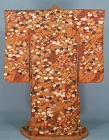Japanese Gallery (Honkan) Room T2
June 24, 2009 (Wed) - July 20, 2009 (Mon)
With the establishment of the Kamakura shogunate in the late 12th century, warriors replaced court nobles at the forefront of political authority. Initially, these warriors utilized court robes as formal attire, however with time, stately variants of suo and hitatare suits (which warriors had previously worn) became their official dress.
In the tumultuous era at the turn of the 16th century, a distinctive battlefield aesthetic emerged, embodied in jinbaori coats worn over armor. Many jinbaori made use of unusual materials such as the vanes of bird feathers or fabrics and accessories from the Western world, obtained through trade. With their exotic materials, flamboyant colors and novel designs, jinbaori exhibit exemplary craftsmanship and surprising creativity which, at times, supersedes all notions of practicality. Each dressed in their own unique jinbaori, warriors must have looked proud and splendid on the battlefield. Similarly following court style, the wives and daughters of warriors wore uchiki-bakama trousers in the Kamakura period (1192-1333), after the fashion of noble ladies. In the Muromachi period (1392-1573), however, this was replaced by the style of wearing uchikake-type kosode garments without uchiki-bakama. During the late Edo period (1603-1868), designs on the kosode and obi sashes of warrior-class women came to follow a distinctive style, and the highest-ranking ladies wore sumptuous embroidery and weaves such as ordinary townswomen could only dare to dream of.
While warriors valued simplicity and economy they also felt a strong sense of pride and dignity in their rank, as expressed by the luxuriance of their costumes.

